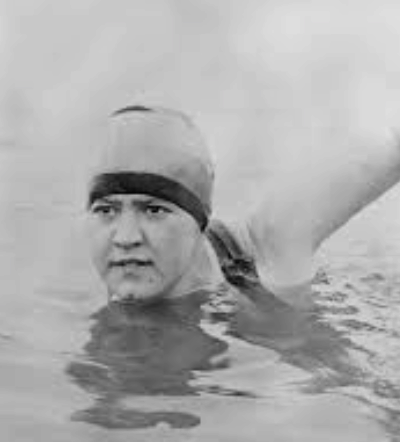Bathing suits that gave women the freedom to swim were considered scandalous and women were expected to wear stockings for swimming competitions when Gertrude “Trudy” Ederle decided to compete. Only when women agreed to robe as soon as they stepped out of the water did men agree to remove these impediments from the sport.
Gertrude Ederle was nine when she began to swim and did not learn proper technique until she was fifteen. A year later, she won her first competition and between 1921 and 1925 set twenty-nine amateur records. In 1924 she went to the Olympics in Paris and won a gold medal with the U.S. team in the women’s 4×100-meter freestyle relay. She also took individual bronze medals in the women’s 100-meter freestyle and women’s 400-meter freestyle.
“Trudy” later lamented that she had not won three gold medals but proclaimed herself proud to be a part of the American team that won 99 medals. Swimmer Johnny Weissmuller, oarsman Benjamin Spock and tennis player Helen Wills were some of the other competitors. (Another team member, DeHart Hubbard, was the first black man to win an individual gold medal.)
Ederle was the first woman to swim the length of New York Bay—beating the records of the men who had preceded her, a foreshadowing for her future. When she set her sights on swimming the English Channel, there were several woman attempting the same feat and she felt pressure to be the first. During her first attempt her trainer forced her out of the water. She disagreed with his decision, fired him, and hired another coach, Tom Burgess. On her second attempt, once again the coach, encouraged her to quit. “Gertie, you must come out!” he insisted as the galling winds swirled around her. She lifted her head from the choppy waters and replied, “What for?” Her family, on an accompanying tug, supported her decision and she finished the swim she had begun in France at Cape Griz-Nez. Fourteen hours and thirty-nine minutes later she came ashore at Kingsdown, Kent, England—bettering the time of the five men who preceded her by two hours. She was greeted by an immigration official who demanded to see her passport.
After this Ederle traveled with vaudeville. In 1933 Ederle injured her back and could no longer compete but she did swim in the “Aquacade” at the 1939 New York World’s Fair, along with Johnny Weismuller, Buster Crabbe and Esther Williams, who had trained at the same club in New York as Ederle.
Due to a childhood bout of measles, and probably exacerbated by the Channel swim, Ederle lost her hearing. It was only natural that she would teach swimming to deaf children. She died at the age of 98. In 2008, five years after her death, BBC presented a radio play dramatizing her feat. It was repeated in 2010 and 2012. The Gertrude Ederle Recreation Center in the Upper West Side of Manhattan, not far from where she grew up and learned to swim, stands in her honor.
LEARN MORE:
Read a short biography: http://www.biography.com/people/gertrude-ederle-9284131
Read a longer biography: America’s Girl: The Incredible Story of How Swimmer Gertrude Ederle Changed the Nation by Tim Dahlberg
For an eight grade girl’s view of Ederle, watch the well-designed video: http://www.youtube.com/watch?v=2jfGy3pzKvc
QUESTION OF THE WEEK:
Gertrude Ederle dropped out of high school to pursue her goal. Have you ever made a sacrifice to achieve a dream?

